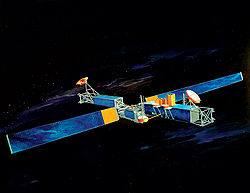Milstar

Milstar (originally an acronym for Military Strategic and Tactical Relay [satellite], but now a name with no inherent meaning) is a United States government satellite communications system that provides secure, jam resistant, worldwide communications to meet wartime requirements for United States military users.
Features
Milstar is the most advanced U.S. military satellite communications (MILSATCOM) system deployed to date. It is a joint service system, i.e. it serves the communication requirements of the United States Army, Navy, Marine Corps, and Air Force. The operational Milstar satellite constellation consists of five satellites positioned around the Earth in geosynchronous orbits. Each mid-latitude satellite weighs approximately 10,000 lb (4,536 kg) and has a design life of 10 years.
Each Milstar satellite serves as a smart "switchboard" in space by directing traffic from terminal to terminal anywhere on the Earth. Since the satellite actually processes the communications signal and can link with other Milstar satellites through crosslinks, the requirement for ground controlled switching is significantly reduced. The satellite establishes, maintains, reconfigures and disassembles required communications circuits as directed by the users. Milstar terminals provide encrypted voice, data, teletype or facsimile communications. A key goal of Milstar is to provide interoperable communications among the users of Army, Navy, and Air Force Milstar terminals.
Geographically dispersed mobile and fixed control stations provide survivable and enduring operational command and control for the Milstar constellation.
Background
The first Milstar satellite was launched 7 February, 1994 aboard a Titan IV expendable launch vehicle. The second was launched 5 November 1995. These satellites were later known as Milstar Block I. A block change occurred starting with the third satellite, where an additional medium data rate payload was added to the satellite. The third launch on 30 April 1999, placed the satellite in a non-usable orbit. The remaining satellites were launched on 27 February 2001, 15 January 2002, and 8 April 2003.
The Milstar system is composed of three segments: space (the satellites), terminal (the users) and mission control. The Military Satellite Communications (MILSATCOM) division of Air Force Space Command's Space and Missile Systems Center at Los Angeles AFB, California, is responsible for development and acquisition of the Milstar space and mission control segments. The Electronic Systems Center at Hanscom AFB, Massachusetts, is responsible for the Air Force portion of the terminal segment development and acquisition. The 4th Space Operations Squadron at Schriever AFB, Colorado,and the 148th Space Operations Squadron at Vandenberg AFB, California; are the front line organizations providing real-time satellite platform control and communications payload management.
Characteristics
- Primary function: Global military communications system
- Primary contractor: Lockheed Martin Missiles and Space
- Power plant: Solar panels generating 8 kW
- Weight: ~10,000 lb (4,500 kg)
- Orbit altitude: 22,250 nautical miles (41,200 km) geosynchronous
- Payload:
- Low data rate communications (voice, data, teletype and facsimile) at 75 bit/s to 2,400 bit/s (All satellites)
- Medium data rate communications (voice, data, teletype and facsimile) at 4.8 kbit/s to 1.544 Mbit/s (Satellites 3 through 6 only)
- Frequency plan: Q-Band uplink, Ka-Band downlink
- Crosslinks: System supports string or ring satellite to satellite communications
- Mission: Protected Communications: Anti-jam, low probability of intercept and detect, Nuclear survivable
- Launch vehicle: Titan IVB/Centaur upper stage
- Inventory: 5
- Unit Cost: $800 million, then-year dollars
- Milstar 1 launched 1994-02-07 1994-009A USA-99
- Milstar 2 launched 1995-11-06 1995-060A USA-115
- Milstar 3 launched 1999-04-30 1999-023A USA-143, accidentally inserted into useless orbit
- Milstar 4 launched 2001-02-27 2001-009A USA-157
- Milstar 5 launched 2002-01-16 2002-001A USA-164
- Milstar 6 launched 2003-04-08 2003-012A USA-169
Related Systems
Other MILSATCOM systems include (organized by product line):
| Protected Comm | Wideband Comm | Network Comm |
|---|---|---|
| Milstar | Defense Satellite Communications System (DSCS) | Transformational Satellite Communications System (TSAT) -- a future system (also continuing the protected and wideband lines) |
| Advanced Extremely High Frequency satellite (AEHF) -- a near-future system | Wideband GlobalSat Comm System (WGS) -- a near-future system |
External links
Source
This page contains information that originally came from a U.S. Government website, in the public domain.

